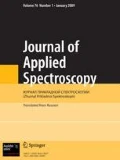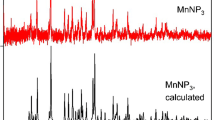A 31P NMR study was carried out to determine the composition of phosphomolybdic acids (PMA) formed in the reaction of molybdenum oxide and phosphoric acid with Mo/P molar ratio = 12. The molybdenum oxide conversion increases with dilution of the reaction mixture. The major product of this reaction over the entire range of conditions studied was the acid H7PMo11O39. The maximum concentration of H3PMo12O40 acid is achieved when the H2O:MoO3 mass ratio is 10, which is optimal for the preparative synthesis of PMA (84% yield).
Similar content being viewed by others
References
P. K. Zarzycki, M. A. Bartoszuk, and A. RadziwonBalicka, J. Planar Chromatogr., 19, 52–57 (2006).
R. L. Prior, X. Wu, and K. Schlach, J. Agric. Food Chem., 53, No. 10, 4290–4302 (2005).
I. I. Vorontsov, The Production of Organic Dyes [in Russian], Goskhimizdat, Moscow (1962).
A. A. Pimerzin, N. N. Tomina, N. M. Maksimov, V. S. Tsvetkov, and P. S. Solmanov, Method for the Catalyst Preparation and a Catalyst for the Extensive Hydroupurifi cation of Petroleum Fractions [in Russian], Russian Federation Patent 2486010 (2013).
A. N. Loginova, I. M. Krukovsky, Ya. V. Mikhailova, V. V. Fadeev, E. A. Isaeva, and A. V. Leont'ev, Catalyst for the Hydropurifi cation of Diesel Fractions and a Method for Its Preparation [in Russian], Russian Federation Patent 2566307 (2015).
A. Gribobal, P. Blanchard, E. Payen, M. Fournier, and J. L. Dubois, Catal. Today, 45, 277–283 (1998).
O. V. Klimov, M. A. Fedotov, A. V. Pashigreva, S. V. Budukva, E. N. Kirichenko, G. A. Bukhtiyarova, and A. S. Novikov, Kinetics and Catalysis, 50, No. 6, 867–873 (2009).
M. T. Pope and A. Müller (editors), Polyoxometalate Chemistry from Topology via SelfAssembly, Kluwer Academic Publishers, New York–Boston–Dordrecht–London–Moscow (2002).
E. A. Nikitina, Heteropoly Compounds [in Russian], GNII Khimicheskoi Literatury, Moscow (1962).
J. F. Keggin, Proceedings Roy. Soc. London A, 144, 75–100 (1934).
R. Strandberg, Acta Chem. Scand., 27, 1004–1018 (1973).
Gmelin Handbook of Inorganic Chemistry, 8th edn., Molybdenum Suppl. Vol. B 3b. Molybdate and Peroxomolybdate Ions, Springer Verlag, Berlin–Heidelberg (1989), pp. 90–94, 102–104.
J. A. R. van Veen, O. Sudmeijer, C. A. Emeis, and H. de Wit, J. Chem. Soc., Dalton Trans., No. 9, 1825–1831 (1986).
D. Bajuk-Bogdanović, I. Holclajtner-Antunović, M. Todorović, U. B. Mioč, and J. Zakrzewska, J. Serbian Chem. Soc., 73, No. 2, 197–209 (2008).
G. A. Tsigdinos, Top. Curr. Chem., 76, 1–64 (1978).
C. C. Kirchner and S. R. Crouch, Anal. Chem., 55, 242–248 (1983).
http://www.vekton.ru/menu/price/ site of AO Vekton, 2019 (correspondence date July 22, 2019).
K. Murata and S. Ikeda, Polyhedron, 2, No. 10, 1005–1008 (1983).
G. M. Maksimov, Usp. Khim., 64, No. 5, 480–496 (1995).
G. Johannson, L. Petterson, and N. Igri, Acta Chem. Scand., 32A, 407–414 (1978).
L. Petterson, I. Andersson, and L.-O. Ohman, 25, 4726–4733 (1986).
X. Lopez, J. J. Carbo, C. Bo, and J. M. Poblet, Chem. Soc. Rev., 41, 7537–7571 (2012).
J. J. Borras-Almenar, E. Coronado, A. Müller, and M. Pope (Eds.), Polyoxometalate Molecular Science, Springer- Science+Business Media, Dordrecht (2003).
A. Rosenheim and J. Jaenicke, Z. Anorg. Chem., 101, No. 1, 235–275 (1917).
H. Wu, J. Biol. Chem.¸43, No. 1, 189–220 (1920).
G. M. Maksimov, R. I. Maksimovskaya, and I. V. Kozhevnikov, Zh. Neorg. Khim., 39, No. 4, 623–628 (1994) [Russ. J. Inorg. Chem., 39, No. 4, 595–600 (1994)].
A. F. Gafarova, N. Kh. Bekmetova, V. V. Kuril'skaya, A. M. Volkova, Zh. Ya. Onopchenko, and N. V. Pavlova, Method for the Preparation of Phosphomolybdic Acid [in Russian], USSR Patent 1,039,875 (1982).
G. A. Tsigdinos, Ind. Eng. Chem., Prod. Res. Develop., 13, 267–274 (1974).
China Tungsten, 2019: http//www.molybdenum.com.en/phosphomolybdicacidhydrateproduction-processes.html/(correspondence date July 23, 2019).
L. E. Briand, G. M. Vallea, and H. J. Thomas, J. Mater. Chem., 12, 299–304 (2002).
S. Himeno, M. Hashimoto, and T. Ueda, Inorg. Chim. Acta, 284, 237–245 (1999).
M. A. Fedotov and R. I. Maksimovskaya, Zh. Strukt. Khim., 47, No. 5, 961–984 (2006).
Author information
Authors and Affiliations
Corresponding author
Additional information
Translated from Zhurnal Prikladnoi Spektroskopii, Vol. 87, No. 2, pp. 252–260, March–April, 2020.
Rights and permissions
About this article
Cite this article
Krukovsky, I.M., Sheloumov, A.M., Golubev, O.V. et al. Optimization of Phosphomolybdic Acid Synthesis using 31p NMR Data. J Appl Spectrosc 87, 267–274 (2020). https://doi.org/10.1007/s10812-020-00995-3
Received:
Published:
Issue Date:
DOI: https://doi.org/10.1007/s10812-020-00995-3




